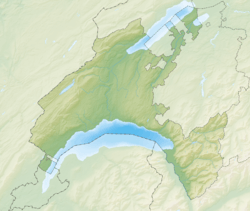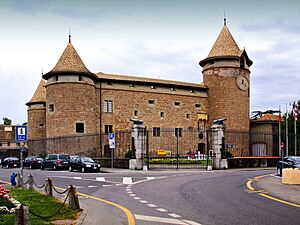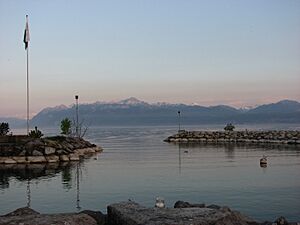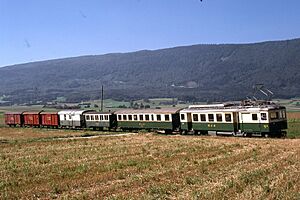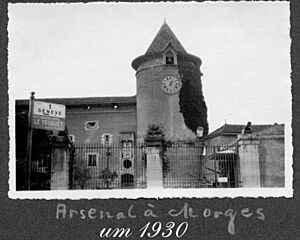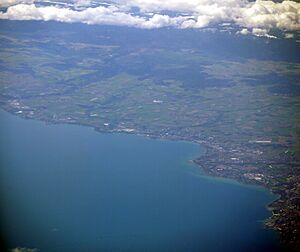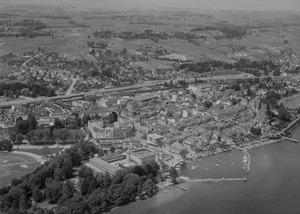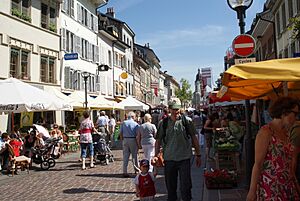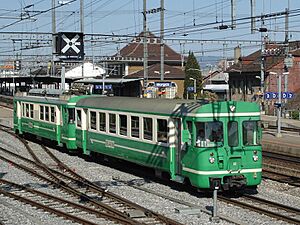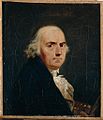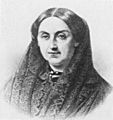Morges facts for kids
Quick facts for kids
Morges
|
||
|---|---|---|
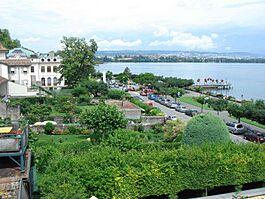
Morges lakefront
|
||
|
||
| Country | Switzerland | |
| Canton | Vaud | |
| District | Morges | |
| Area | ||
| • Total | 3.83 km2 (1.48 sq mi) | |
| Elevation | 374 m (1,227 ft) | |
| Population
(Dec 2020 )
|
||
| • Total | 16,101 | |
| • Density | 4,204/km2 (10,888/sq mi) | |
| Postal code |
1110
|
|
| Surrounded by | Chigny, Echichens, Lonay, Monnaz, Préverenges, Publier (FR-74), Tolochenaz, Vufflens-le-Château | |
| Twin towns | Vertou (France), Rochefort (Belgium) | |
Morges is a charming town in Switzerland. It is located in the Vaud canton, right on the beautiful Lake Geneva. Morges is west of Lausanne and is the main town of the Morges district.
Contents
Exploring Morges' Past
Morges was first mentioned in records in 1288. It was once known by a German name, Morsee, but that name is no longer used today.
Ancient Settlements by the Lake
Long, long ago, people lived along the shores of what is now Morges. The biggest and most famous settlement was called Grande-Cité. People lived there during the late Bronze Age. Scientists used a method called dendrochronology (dating wood by its tree rings) to find out that one wooden object from Grande-Cité was made in 1031 BC. Many old wooden structures are still preserved there.
Another village, Vers-l'Église, was about 100 meters north. People lived there even earlier, in the Neolithic period (around 2900 BC to 2700 BC). It was also used during the Late Bronze Age.
A third lake settlement, Les Roseaux, dates back to the Early Bronze Age. Many interesting items like bronze axe parts and ceramic cups have been found there. The way the stilts were arranged shows how the huts were organized. Houses were built between 1776 BC and 1600 BC. A smaller settlement from 1055 BC was found on top of the older one.
These Bronze Age settlements were eventually left empty. The area was not very populated until the Gallo-Roman era, when villas and farms were built.
Morges in the Middle Ages
In 1286, Louis of Savoy started building a new city in a field. A castle was built to protect the city. Morges was given its own special rules in 1293. The new city quickly grew into an important place for trade and administration. It became a center for moving goods by land and water.
During the Middle Ages, Morges was a temporary home for the House of Savoy rulers. It was also the main office for a local official called a bailiff. The city was designed with two wide main streets for markets. A third street was added later because the city grew so fast. A rectangular market square was also created. Houses were often long and narrow, with courtyards for light.
The castle in the south of the town square was built with a square shape and four round towers. It looked similar to Yverdon Castle. One tower was larger and served as the main tower. A unique fortified kitchen was built outside the castle walls on the lake side.
The first city leaders, called Syndics, were mentioned in Morges in 1375. The Town Hall was built around 1515-20. It is the oldest public building of its kind in Vaud. Before this, public meetings were held in the church or other buildings.
The town had its own weights and measures, two community ovens, and a hospital.
During the Middle Ages, the town's chapel was part of a church in Joules. By 1490, it was dedicated to Notre-Dame. The chapel was later turned into a Reformed church in 1537. It was taken down in 1769.
Outside the city walls, there was a Franciscan monastery. It was founded around 1497-1500. Troops damaged it in 1530 and again in 1536. A cemetery was later built on the ruins.
Morges in Early Modern Times
The city and castle were attacked in 1475 and 1530. After the region was taken over by Bern in 1536, Morges became the center of a new district in 1539. The castle was repaired and made stronger for cannons. The city gates were taken down.
Morges became very successful during this time. Many large public and private buildings were constructed. These included a granary (a building for storing grain) and several impressive houses. A latin school was already running by the late 1400s. In 1574, the Collège de Couvaloup, a new school, opened in Morges. The new church, built between 1769–76, is a beautiful example of Reformed architecture.
From the late 1700s, areas outside the city walls began to be built up. New neighborhoods and country estates appeared along the roads to Lausanne and Geneva. A small harbor was mentioned in 1536. Regular boat service to Geneva started soon after. The current port, with its two curved walls, was built between 1691–96. A customs house was finished in 1702. With the port, Morges became a key point for trade routes. Goods like salt, wine, and grain were moved through here.
The local economy started to focus more on transportation and trade. Shoemakers were important in the 1500s and 1600s. Later, tanners (people who prepare animal hides) became more significant.
Morges in Modern Times
The first railway line in the canton connected Yverdon to Morges in 1855. This new train station led to a lot of building outside the city walls. More lines followed, connecting Morges to Lausanne in 1856 and Geneva in 1858. In 1895, the Morges-Bière-Apples line was completed, opening up the countryside.
Morges grew into an important center for business, politics, and culture. After the French invasion in 1798, Morges became a district capital.
In the late 1800s, the city's economy improved thanks to the steamship port and its connection to the railway. The castle became a cantonal armory (a place to store weapons) in 1803. It was expanded and later housed the Vaud Military Museum starting in 1925.
A Catholic church was built in 1844. In 1922, the cantonal Farming and Wine Production school was founded.
Several companies shaped the economy in the 1900s, including a gas factory, a transport company, a biscuit factory, and a pasta factory. Between 1900 and 1940, the city continued to expand with new homes and neighborhoods. A highway was built between 1961 and 1964, dividing the town. Since 2007, Morges has been part of a project to create more jobs in the Lausanne-Morges area.
Morges' Location and Landscape
Morges covers an area of about 3.9 square kilometers (1.5 square miles).
- About 21% of the land is used for farming.
- About 4.7% is covered by forests.
- Most of the land, about 73.5%, is built up with buildings and roads.
- A small part, 1%, is rivers or lakes.
Morges is the capital of its district. It is located about 10 kilometers (6 miles) southwest of Lausanne, along a bay in Lake Geneva.
Morges' Coat of Arms
The blazon (description) of Morges' coat of arms is: Per fess Argent and Gules, two Bars wavy counterchanged. This means it has a silver top and a red bottom, with two wavy lines that switch colors.
This design represents the two rivers that flow on either side of the town: the Bief to the east and the Morges river to the west.
Morges' Population
Morges has a population of about 17,755 people (as of 2023). Many people from other countries live here.
Most people in Morges (about 82.3%) speak French. German is the second most common language (4.2%), followed by Italian (4.0%).
The population of Morges has grown over time. Here's how it has changed:

Important Heritage Sites
Morges is home to several important historical sites. The Les Roseaux and Stations de Morges prehistoric pile-dwelling (stilt house) settlements are part of a UNESCO World Heritage Site. This means they are very important to human history.
Other important sites include:
- The De La Croix Blanche Inn
- Buildings at Grand-Rue 54 and Grand-Rue 94
- Morges Castle and the Military Museum of Vaud
- The City Hall
- The Bronze Age shore settlement Les Roseaux/La Grande Cité
- The Temple (church)
The entire old city of Morges is also recognized as an important Swiss heritage site.
Sister Cities
Morges is connected to other cities around the world through a program called town twinning.
Morges' Economy
Morges has a low unemployment rate, which means most people who want to work can find jobs. In 2008, there were over 7,200 people working in the municipality. Many jobs are in the service industry, like sales, transportation, hotels, and healthcare.
About 25.6% of workers use public transportation to get to work. About 52.1% use a private car.
Getting Around Morges
Morges has a train station served by the Swiss Federal Railways and the Bière–Apples–Morges railway (BAM). You can also travel by boat on Lake Geneva with the CGN company. The main east-west Swiss A1 motorway also passes through Morges.
Religion in Morges
According to a 2000 census, about 38.4% of the population belonged to the Swiss Reformed Church. About 34.8% were Roman Catholic. Other Christian churches, as well as Islam and other religions, are also present. About 13.1% of the population did not belong to any church.
Education in Morges
Many people in Morges have completed higher education. About 35.3% have finished high school, and 15.3% have gone on to university or other higher education.
In the 2009/2010 school year, there were over 1,400 students in Morges schools. The canton provides two years of optional pre-school. Primary school lasts for four years, and lower secondary school lasts for six years.
Morges is home to two museums:
- The Musée militaire (Military Museum)
- The Musée Paderewski
The Bibliothèque municipale de Morges (Morges Municipal Library) has over 33,000 books and other media.
Sports in Morges
Morges has local sports teams:
- The HC Forward-Morges plays ice hockey in the Swiss 1. Liga.
- The YC Yens-Morges plays Unihockey (a type of floorball).
Famous People from Morges
Morges has been home to many interesting people throughout history.
From Early Times
- Margaret of Savoy, Duchess of Anjou (1420–1479): A daughter of a Duke of Savoy.
From the 18th Century
- Henri de Catt (1725–1795): A Swiss scholar who was a private secretary to Frederick the Great of Prussia.
- Jean-André Venel (1740–1791): A Swiss doctor who was a pioneer in orthopedics (the study of bones and muscles).
- Jean-François Sablet (1745–1819): A French painter.
- Jean-Marc Mousson (1776–1861): A politician who was the first Chancellor of Switzerland.
- Fernán Caballero (1796–1877): The pen name of Spanish novelist Cecilia Francisca Josefa Böhl de Faber.
From the 19th Century
- Louis Buvelot (1814–1888): A landscape painter who influenced the Heidelberg School of painters.
- François-Alphonse Forel (1841–1912): A scientist who started the study of lakes, called limnology.
- Eugen Bracht (1842–1921): A German landscape painter.
- Auguste-Henri Forel (1848–1931): A scientist who studied ants (a myrmecologist), the brain (a neuroanatomist), and mental health (a psychiatrist).
- Henryk Opieński (1870–1942): A Polish composer, violinist, and music teacher.
- Milo Martin (1893–1970): A Swiss sculptor.
From the 20th Century
- Igor Stravinsky: A famous Russian-born composer who lived in Morges from 1915 to 1920.
- Queen Anne of Romania (1923–2016): The wife of the former king Michael I of Romania.
- Patrick Moraz (born 1948): A Swiss keyboard player who played with famous bands like Yes and The Moody Blues.
- Ignacy Jan Paderewski: A Polish pianist and politician.
- Nuria Gorrite (born 1970): Grew up in Morges and is now the President of the Council of State of Vaud.
Sports Stars
- Jean Schopfer (1868–1931): A French tennis player and writer.
- Olivier Anken (born 1957): A retired ice hockey player.
- Dominique Bosshart (born 1977): A Canadian taekwondo athlete who won a bronze medal at the 2000 Summer Olympics.
- Jonathan Massacand (born 1984): A swimmer who competed in the 2008 Summer Olympics.
- Yannick Weber (born 1988): A Swiss professional ice hockey player.
- Yann Sommer (born 1988): A Swiss football (soccer) goalkeeper.
- Nikola Vučević (born 1990): A Montenegrin professional basketball player.
- Lara Michel (born 1991): A Swiss tennis player.
Images for kids
See also
 In Spanish: Morges para niños
In Spanish: Morges para niños




